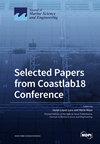Salinity Prediction Based on Improved LSTM Model in the Qiantang Estuary, China
IF 2.8
3区 地球科学
Q1 ENGINEERING, MARINE
引用次数: 0
Abstract
Accurate prediction of estuarine salinity can effectively mitigate the adverse effects of saltwater intrusion and help ensure the safety of water resources in estuarine regions. Presently, diverse data-driven models, mainly neural network models, have been employed to predict tidal estuarine salinity and obtained considerable achievements. Due to the nonlinear and nonstationary features of estuarine salinity sequences, this paper proposed a multi-factor salinity prediction model using an enhanced Long Short-Term Memory (LSTM) network. To improve prediction accuracy, input variables of the model were determined through Grey Relational Analysis (GRA) combined with estuarine dynamic analysis, and hyperparameters for the LSTM model were optimized using a multi-strategy Improved Sparrow Search Algorithm (ISSA). The proposed ISSA-LSTM model was applied to predict salinity at the Cangqian and Qibao stations in the Qiantang Estuary of China, based on measured data from 2011–2012. The model performance is evaluated by mean absolute error (MAE), mean absolute percentage error (MAPE), root mean square error (RMSE), and Nash-Sutcliffe efficiency (NSE). The results show that compared to other models including Back Propagation neural network (BP), Gate Recurrent Unit (GRU), and LSTM model, the new model has smaller errors and higher prediction accuracy, with NSE improved by 8–32% and other metrics (MAP, MAPE, RMSE) improved by 15–67%. Meanwhile, compared with LSTM optimized with the original SSA (SSA-LSTM), MAE, MAPE, and RMSE values of the new model decreased by 13–16%, 15–16%, and 11–13%, and NSE value increased by 5–6%, indicating that the ISSA has a better hyperparameter optimization ability than the original SSA. Thus, the model provides a practical solution for the rapid and precise prediction of estuarine salinity.基于改进型 LSTM 模型的中国钱塘江河口盐度预测
准确预测河口盐度可有效缓解海水入侵的不利影响,有助于确保河口地区的水资源安全。目前,以神经网络模型为主的多种数据驱动模型已被用于预测潮汐河口盐度,并取得了不俗的成绩。鉴于河口盐度序列的非线性和非稳态特征,本文提出了一种使用增强型长短期记忆(LSTM)网络的多因素盐度预测模型。为提高预测精度,通过灰色关系分析(GRA)结合河口动态分析确定了模型的输入变量,并使用多策略改进麻雀搜索算法(ISSA)优化了 LSTM 模型的超参数。根据 2011-2012 年的实测数据,将所提出的 ISSA-LSTM 模型用于预测中国钱塘江口仓前站和七宝站的盐度。通过平均绝对误差(MAE)、平均绝对百分比误差(MAPE)、均方根误差(RMSE)和纳什-苏特克利夫效率(NSE)对模型性能进行了评估。结果表明,与其他模型(包括反向传播神经网络(BP)、门递归单元(GRU)和 LSTM 模型)相比,新模型的误差更小,预测精度更高,NSE 提高了 8-32%,其他指标(MAP、MAPE、RMSE)提高了 15-67%。同时,与使用原始 SSA 优化的 LSTM(SSA-LSTM)相比,新模型的 MAE、MAPE 和 RMSE 值分别降低了 13-16%、15-16% 和 11-13%,NSE 值提高了 5-6%,表明 ISSA 比原始 SSA 具有更好的超参数优化能力。因此,该模型为河口盐度的快速、精确预测提供了一种实用的解决方案。
本文章由计算机程序翻译,如有差异,请以英文原文为准。
求助全文
约1分钟内获得全文
求助全文
来源期刊

Journal of Marine Science and Engineering
Engineering-Ocean Engineering
CiteScore
4.40
自引率
20.70%
发文量
1640
审稿时长
18.09 days
期刊介绍:
Journal of Marine Science and Engineering (JMSE; ISSN 2077-1312) is an international, peer-reviewed open access journal which provides an advanced forum for studies related to marine science and engineering. It publishes reviews, research papers and communications. Our aim is to encourage scientists to publish their experimental and theoretical results in as much detail as possible. There is no restriction on the length of the papers. The full experimental details must be provided so that the results can be reproduced. Electronic files and software regarding the full details of the calculation or experimental procedure, if unable to be published in a normal way, can be deposited as supplementary electronic material.
 求助内容:
求助内容: 应助结果提醒方式:
应助结果提醒方式:


